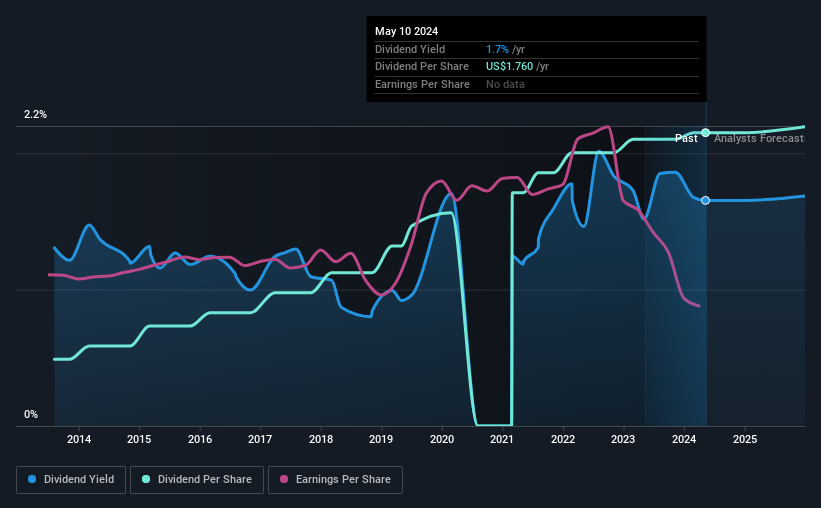- United States
- /
- Healthcare Services
- /
- NYSE:USPH
U.S. Physical Therapy (NYSE:USPH) Is Due To Pay A Dividend Of $0.44

The board of U.S. Physical Therapy, Inc. (NYSE:USPH) has announced that it will pay a dividend of $0.44 per share on the 14th of June. This takes the annual payment to 1.7% of the current stock price, which is about average for the industry.
See our latest analysis for U.S. Physical Therapy
U.S. Physical Therapy's Earnings Easily Cover The Distributions
We like a dividend to be consistent over the long term, so checking whether it is sustainable is important. Based on the last payment, U.S. Physical Therapy's profits didn't cover the dividend, but the company was generating enough cash instead. Generally, we think cash is more important than accounting measures of profit, so with the cash flows easily covering the dividend, we don't think there is much reason to worry.
The next year is set to see EPS grow by 188.2%. Under the assumption that the dividend will continue along recent trends, we think the payout ratio could be 58% which would be quite comfortable going to take the dividend forward.

Dividend Volatility
While the company has been paying a dividend for a long time, it has cut the dividend at least once in the last 10 years. The dividend has gone from an annual total of $0.40 in 2014 to the most recent total annual payment of $1.76. This means that it has been growing its distributions at 16% per annum over that time. Despite the rapid growth in the dividend over the past number of years, we have seen the payments go down the past as well, so that makes us cautious.
Dividend Growth May Be Hard To Achieve
With a relatively unstable dividend, it's even more important to evaluate if earnings per share is growing, which could point to a growing dividend in the future. U.S. Physical Therapy has seen earnings per share falling at 4.1% per year over the last five years. If the company is making less over time, it naturally follows that it will also have to pay out less in dividends. It's not all bad news though, as the earnings are predicted to rise over the next 12 months - we would just be a bit cautious until this can turn into a longer term trend.
We should note that U.S. Physical Therapy has issued stock equal to 15% of shares outstanding. Regularly doing this can be detrimental - it's hard to grow dividends per share when new shares are regularly being created.
U.S. Physical Therapy's Dividend Doesn't Look Sustainable
In summary, while it's always good to see the dividend being raised, we don't think U.S. Physical Therapy's payments are rock solid. In the past, the payments have been unstable, but over the short term the dividend could be reliable, with the company generating enough cash to cover it. We don't think U.S. Physical Therapy is a great stock to add to your portfolio if income is your focus.
Companies possessing a stable dividend policy will likely enjoy greater investor interest than those suffering from a more inconsistent approach. Still, investors need to consider a host of other factors, apart from dividend payments, when analysing a company. For instance, we've picked out 5 warning signs for U.S. Physical Therapy that investors should take into consideration. Looking for more high-yielding dividend ideas? Try our collection of strong dividend payers.
New: AI Stock Screener & Alerts
Our new AI Stock Screener scans the market every day to uncover opportunities.
• Dividend Powerhouses (3%+ Yield)
• Undervalued Small Caps with Insider Buying
• High growth Tech and AI Companies
Or build your own from over 50 metrics.
Have feedback on this article? Concerned about the content? Get in touch with us directly. Alternatively, email editorial-team (at) simplywallst.com.
This article by Simply Wall St is general in nature. We provide commentary based on historical data and analyst forecasts only using an unbiased methodology and our articles are not intended to be financial advice. It does not constitute a recommendation to buy or sell any stock, and does not take account of your objectives, or your financial situation. We aim to bring you long-term focused analysis driven by fundamental data. Note that our analysis may not factor in the latest price-sensitive company announcements or qualitative material. Simply Wall St has no position in any stocks mentioned.
About NYSE:USPH
U.S. Physical Therapy
Operates and manages outpatient physical therapy clinics.
Excellent balance sheet with proven track record and pays a dividend.
Similar Companies
Market Insights
Community Narratives




